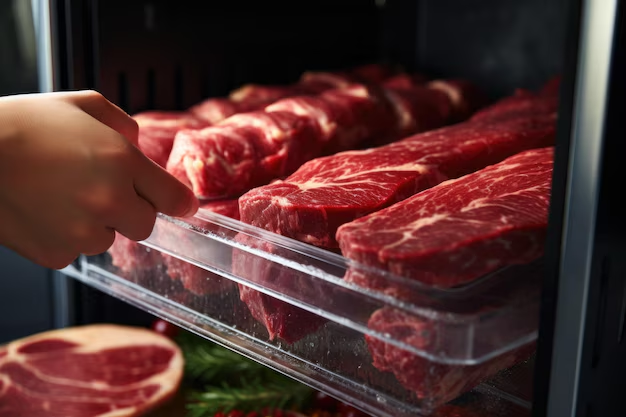How Long Can You Really Keep Steak in the Refrigerator? A Complete Guide to Food Safety and Storage
At the heart of any well-prepared meal lies the quality of the ingredients used, and when it comes to steak, freshness isn't just a preference—it's a necessity. Ensuring your steak remains safe and delicious requires proper storage techniques, starting with how long you can keep it in the refrigerator. Whether you're a culinary novice or a seasoned home chef, understanding the nuances of food storage can safeguard your health and enhance your culinary creations. So, let's dive into the essentials of keeping steak fresh in your fridge.
📅 How Long Can Steak Last in the Refrigerator?
Fresh Steak Storage Guidelines
When it comes to storing fresh steak in the refrigerator, the general rule of thumb is to use it within 3 to 5 days. This timeframe depends on several factors, including the cut, freshness at purchase, and how well it’s stored.
Key considerations:
- Always store steak at 40°F (4°C) or below to slow bacterial growth.
- Keep the steak wrapped in its original packaging if you plan to use it within a few days, or rewrap it in butcher paper or aluminum foil for added protection.
Cooked Steak Longevity
After you’ve cooked that perfect ribeye or filet mignon, your leftovers can last in the refrigerator for about 3 to 4 days. Proper storage is essential to maintain quality and safety.
Storage tips:
- Allow the steak to cool slightly before refrigerating, but don't leave it out for more than two hours to prevent bacteria from proliferating.
- Use an airtight container to prevent exposure to air and odors from other foods.
🍖 Understanding the Factors that Affect Steak Shelf Life
Packaging Impact
Proper packaging plays a crucial role in extending the shelf life of steak:
- Vacuum-sealed packaging: Can extend the fridge life of steak, thanks to reduced oxygen exposure which slows spoilage.
- Butcher paper or aluminum foil: Helps protect the texture and moisture content if vacuum sealing isn’t available.
The Role of Marination
Marinating your steak before refrigerating can sometimes extend its shelf life due to the acidic content that can inhibit bacterial growth. However, this is best for short-term storage and flavor enhancement rather than preservation.
Freshness at Purchase
Always start with the freshest possible meat:
- Look for bright red coloring—an indication of freshness.
- Check expiration or sell-by dates.
- Sniff for any off or sour odors, which can suggest the meat is already degrading.
🕵️♀️ Identifying Spoiled Steak
Your senses are your first defense in identifying spoiled steak:
- Appearance: If your steak has a greenish hue or slimy texture, it's time to toss it.
- Smell: A strong, sour, or ammonia-like odor is a clear sign of spoilage.
- Texture: If it feels tacky or sticky, these can be indicators of bacterial growth.
👀 Quick Checklist: Spoiled Steak Indicators
- Unpleasant odor
- Discolored spots
- Slimy feel
🌡️ Best Practices for Storing Steak
Temperature Control
Temperature is key to food safety. Always keep your refrigerator set to 40°F (4°C) or below to minimize bacterial growth and extend the life of your stored foods.
Airtight Packaging
Using airtight containers or vacuum-sealing is critical in preventing moisture loss and exposure to odors. This method maintains a consistent environment around the steak, maximizing freshness.
Arranging and Storing
Store raw steak on the lower shelves of your refrigerator:
- Minimizes the risk of cross-contamination with other foods.
- Keeps juices from dripping onto other items.
🥩 Can You Freeze Steak for Longer Storage?
Freezing Fresh Steak
Freezing extends the shelf life of your steak significantly—in most cases, up to 6 to 12 months. However, texture and flavor preservation require special attention.
Freezing tips:
- Wrap steaks individually in plastic wrap, followed by a layer of aluminum foil or a resealable freezer bag to prevent freezer burn.
- Label each package with the date for easy tracking and rotation.
Thawing Steak Safely
Proper thawing is just as important as proper freezing:
- Thaw steak in the refrigerator 24 hours before use.
- For faster thawing, place the steak in a leak-proof bag and submerge it in cold water, changing the water every 30 minutes.
⚠️ Common Missteps and How to Avoid Them
Storing in the Refrigerator Door
The door is the warmest part of the refrigerator and not ideal for raw meat. Instead, place your steak on a shelf inside, where the temperature is more stable.
Overcrowding the Fridge
An overcrowded refrigerator can lead to improper air circulation, causing uneven cooling. Ensure there’s enough space for air to flow around the steak.
📝 Summary Table: Steak Storage Tips and Lifespan
| Kind of Steak | Refrigerator Storage | Freezer Storage | Key Tips |
|---|---|---|---|
| Fresh, Uncooked | 3 to 5 days | 6 to 12 months | Use airtight wrapping |
| Cooked | 3 to 4 days | 2 to 3 months | Cool before storing |
| Marinated | Up to 5 days | 6 to 12 months | Use non-reactive containers |
🔍 Final Thoughts
Navigating the intricacies of storing steak properly in your refrigerator can prevent foodborne illness and ensure your meals are both safe and delicious. Understanding how long steak can be stored and the steps to take for extending its shelf life can transform your culinary experience. By adopting these guidelines, you’re not just practicing food safety but also honoring the care and craftsmanship that goes into producing quality steak. With proper storage, you can savor your meals with peace of mind, knowing that you've taken the right steps to protect both tastes and health. Remember, when it comes to food storage, knowledge is your best recipe for success.
